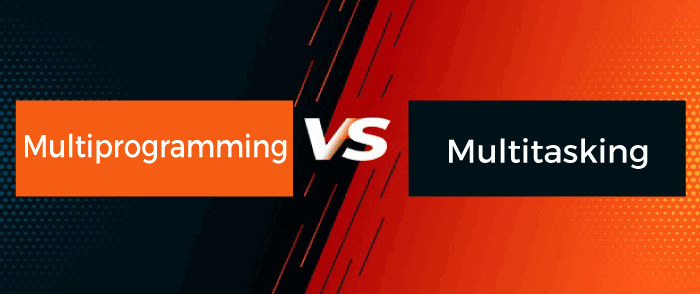Difference between Multiprogramming and MultitaskingThe operating system is an essential component of software that controls the computer's hardware and other software programs. It can be described as a middleman. The user cannot directly issue commands to the CPU in machine language, nor can the CPU directly communicate with the user. As a result, a middleman is required to communicate and translate all interactions between the user and the CPU. Apart from doing basic tasks like managing peripheral devices, displaying output on the screen, and tracking data and files, the operating system also performs higher-level functions such as multiprogramming and multitasking. In this article, you will learn the difference between multiprogramming and multitasking. But before discussing the differences, you need to know about multiprogramming and multitasking. 
What is Multiprogramming?A multiprogramming operating system can run several programs on a single processor machine. If a single application has to wait for I/O transfer in a multiprogramming operating system, other programs are always ready to use the CPU. As a result, numerous jobs can share the CPU's time. However, in a multiprogramming operating system, it is not predefined that their jobs would be executed simultaneously. If a program is in the process of being executed, it is referred to as a "Process", "Job", or "Task". Simultaneous program executions help increase system resource utilization and system throughput performance compared to serial and batch processing systems. Advantages and disadvantages of multiprogrammingThere are various advantages and disadvantages of multiprogramming. Some of them are as follows: Advantages
Disadvantages
What is Multitasking?Multitasking means working on multiple tasks simultaneously, such as using your computer while listening to music. Also, using a browser, search for something on the internet and create a word document that is your assignment. It appears that all of the tasks are taking place at the same time. It is not all of the tasks happening simultaneously; the processor moves between them at such a fast pace that we believe they are happening simultaneously. Multitasking is similar to multiprogramming in that the CPU is assigned to a process for a specified period of time, i.e., 'Time quantum or time slice', after which the CPU 'Context switches' to another process. It runs various programs at the same time. The PC requires a huge memory to execute multitasking (RAM or ROM). Its primary goal is to improve the timing of the CPU's response. Users can engage with the system during multitasking, for example, by typing a letter while the printing process is running. Multitasking is a highly complicated system. It is based on the time slice principle, which assigns a fixed amount of time to each activity to be completed. It is especially useful when a program requires a high level of parallelism. It provides a set amount of time for each program to run. Advantages and disadvantages of multitaskingThere are various advantages and disadvantages of multitasking. Some of them are as follows: Advantages
Disadvantages
Main Differences between the multiprogramming and multitaskingThere are various main differences between multiprogramming and multitasking. Some of them are as follows:
Head to head comparison between multiprogramming and multitaskingHere, there are various head-to-head comparison between multiprogramming and multitasking. Some of them are as follows:
ConclusionThe two aspects of the modern operating system are multiprogramming and multitasking. Multiprogramming is the act of recording several processes in memory and then executing them one by one on a single processor. Multitasking is similar to multiprogramming in that the CPU is assigned to a process for a specific amount of time. It runs multiple programs simultaneously by utilizing multiple CPUs on the same system.
Next TopicNetwork operating system
|
 For Videos Join Our Youtube Channel: Join Now
For Videos Join Our Youtube Channel: Join Now
Feedback
- Send your Feedback to [email protected]
Help Others, Please Share









